
A Cave of Candles / by Dorothy V. Corson

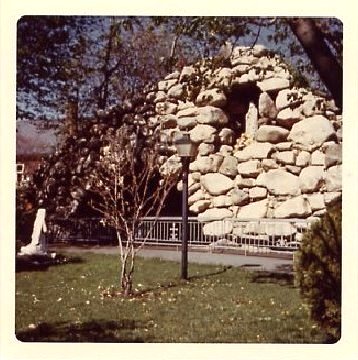
In early 1964, the usual unpredictable Midwest winter had temporarily loosened its icy grip on late February. A sudden thaw had all but erased the last reminders of the sharp, biting winds and blowing drifting snows that had swirled menacingly about us some weeks before, when just before Christmas, we laid my father to rest.
So different, now, these friendly snowflakes, like feathers drifting down, softly and silently, in the peaceful calm of the crisp night air. Falling gently, this time, as if in a parting farewell to the season, to leave a spotless coverlet of winter white as a reverent reminder of the eternalness of winter’s fragile beauty.
Frosty flakes glinting bits of silver against the glow of snow-capped streets lights, rested in crystal clumps on fence posts and rooftops. Fir trees and evergreens laden with frothy snow fashioned a winter fairyland. Now and then, the breath of a breeze dusted a veil of glitter off delicate softly-lighted statuary and settled in gleaming marshmallow mounds on humble rocks and weathered stone.
Captivated by the dancing tree limb shadows, the semi-darkness bathed in luminous moonlight, I felt that fleeting moment to be frozen in timelessness, as though I had stepped into the tranquility of a nighttime snow scene on a glittering Christmas greeting card. Like a vision of beauty is individual -- breathtaking and indescribable -- never to be seen again in the same way or quite the same by two people – the inspiration of the moment evokes an ethereal consciousness we never knew we had.
Gazing pensively, and in silent wonder, I stood entranced, seeing for the first time one of the last things my father – a semi-retired masonry contractor – had built before he died. The starlit sky seemed to be reflected in the pools of light coming from the flickering vigil candles. The beauty of that night, forever etched in my fond memories, softened the sadness I felt, casting a spell of enchantment over a memory that was to linger lovingly in my mind whenever I thought of my father.
I turned to my younger brother, soon to be returning to Alaska, who had brought me to see it for the first time – a replica of the Our Lady of Lourdes Grotto at the University of Notre Dame. A vision of beauty nestled amid the greenery of a parish church and school. “Had you thought,” I asked him, “that when all the buildings Dad ever built are torn down, this might still be standing as a legacy and remembrance of the artistry he had with stone?” He nodded in agreement. As we were driving home, still absorbed in our respective thoughts, I again broke the pregnant silence. “Wouldn’t it be a lovely thought,” I ventured, “if we were allowed to place a small bronze plaque there -- somewhere inconspicuously – in his memory, so that his future grandchildren, those who would never know him, could come and see it?” He grinned at me and added, “Don’t hold your breath.”
Our family heritage is Protestant. I had no close Catholic friends. I knew very little about their religious faith. I had been led to believe that any Catholic institution was a “No Man’s Land” for Protestants. Then how could I even contemplate asking a whimsical favor of a Catholic priest, when I’d never even come close to meeting one? No, I knew I was too timid for that – I couldn’t just walk cold into a Catholic parish church with a request like that – I wouldn’t know where to begin. Yet, I had the strongest feeling that someday, somehow, somewhere -- when the time was right – I’d meet someone who knew the priest or the church and could tell me the story behind how a Protestant and Masonic member happened to be chosen to build it – for no one could doubt that he had put his heart and soul into it.
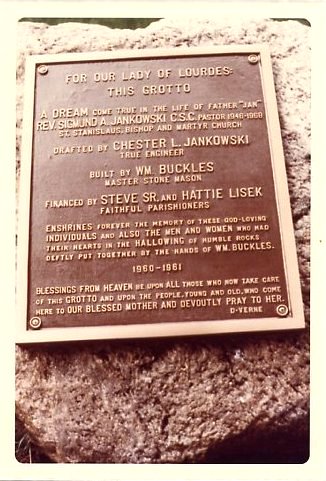 |
FOR OUR LADY OF LOURDES |
The years flew by, as they can, in raising a family. I never returned to the Grotto, except in thought, after that first visit, though I never forgot it, and a vision of that fanciful wintry night revisited me whenever I was reminded of my father.
Then in 1972, on one of those brilliant, sunshiny, spring days – that seem to be meant for something special – I was waiting in line at a cash register in a greeting card shop admiring the unusual weave and texture of the coat on the older woman ahead of me.
Impulsively, I added my unspoken admiration to the compliment the clerk paid her about it. She turned and said, “Why thank you, I made it by hand.” She was so lively and responsive, that I obeyed an irresistible urge to continue our conversation. “Then you must be creative,” I added. “I do paint, too,” she said, and I knew I must have instinctively sensed the artist in her and our mutual interests must have drawn me to her.
My mother, perplexed by my interest in a total stranger, trailed behind us as we talked our way out of the shop. Had I been alone, I know I would have obeyed my intuitive impulse to invite her to join me for a cup of coffee. We both paused in parting, as if mutually aware of a reluctance to move on, then waved goodbye to one another as she turned in the opposite direction.
A half a block further on, as my mother and I neared the office supply store I was headed for, she suggested going on ahead to try on dresses in a department store in the next block. She asked me to meet her there when I’d made my purchase. As she departed, I paused again before entering, hoping I might catch of glimpse of the stranger, but she was nowhere in sight.
Ten minutes later upon leaving the store, I looked back once more in the direction I had last seen her, hoping I just might see her again. We had barely spoken, and yet I had the strongest urge to look for her. For some unfathomable reason I can’t explain, even now, I felt I had to find her and at least get her name and telephone number. Dare I go back, I thought, and look for her . . . I dared!
She looked up in happy surprise when I found her, almost hidden, in the back of the drugstore I thought she might have disappeared into. She told me she had been a widow for two years, was an army nurse during the end of World War II and had traveled widely and married late. She had lived in Switzerland the past twelve years with her Swiss husband, who was in the import business. When he died she returned to South Bend, her hometown, to retire.
In college days she had exhibited nearly one hundred of her paintings at a Chicago university and had since made painting a daily habit in addition to her talented sewing. After a brief chat, we exchanged phone numbers scribbled on our shopping bags and promised to share paintings someday. A strange happenstance encounter, I thought, I wonder if anything will ever come of it.
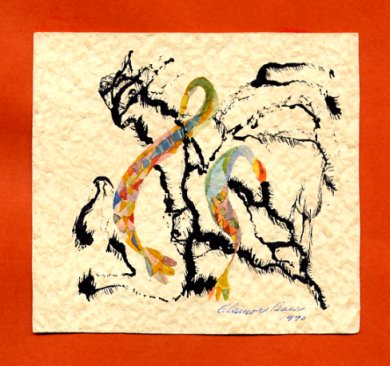 I expected to forget it, at least for a time, but she kept haunting my thoughts. A week later, I decided if fate had planned it, if it was meant to be, she would be able to come for lunch. And so we met again.
As she stepped in the door, she smiled, and handed me this miniature abstract painting, she had painted for me, as a memento of our visit.
I expected to forget it, at least for a time, but she kept haunting my thoughts. A week later, I decided if fate had planned it, if it was meant to be, she would be able to come for lunch. And so we met again.
As she stepped in the door, she smiled, and handed me this miniature abstract painting, she had painted for me, as a memento of our visit.
During lunch she told me of her early travels, of her interesting life abroad, and casually mentioned having been married at St. Stanislaus Church in South Bend before moving to Switzerland. If I could have seen myself, I know I would have been wide-eyed and mouth gaping. “This may puzzle you,” I said, “but I’ve been waiting seven long years to meet someone who knows something about that church and its Grotto, but I never expected it to happen in such a dramatic fashion and through a complete stranger.”
She told me that the Grotto was not there when she was married. She lived in another parish now and went to another church. But her relatives went there and she thought she had heard something recently about the Grotto. “I’ll inquire for you,” she said, “and see what I can find out.”
The week following our visit, a package, decorated with her artwork, arrived from her. A book printed only the year before. It was the memoirs of Rev. Sigmund Jankowski, C.S.C., the priest who built the St. Stanislaus Grotto. It was personally autographed to her and most generous of her to entrust it to a comparative stranger. In his book, Father Jankowski expresses his love for Notre Dame, the influence it had upon his life, and tells of his dream of building an Our Lady of Lourdes Grotto for his own parish church for which he had been the pastor for 22 years.
In her note, my new friend, Eleanor Baer, had written, “I think this is what you were looking for and your father is mentioned in it. He tells of the Protestant stone mason – the only one willing to tackle the challenge – who had been the answer to his prayer.” She then quoted this portion from his book: “I was fortunate to find a expert stone mason, who, himself a Protestant, cheerfully accepted the job, and showed a remarkable interest in the project. He laid rock upon rock so meticulously and faithfully that in a short time a replica of the Grotto of Lourdes and at Notre Dame became a reality.”
“He is retired now,” she wrote, “living at the Fatima Retreat House on the campus of his beloved Notre Dame. “If you would like to meet him,” she continued, “I could arrange a meeting.” To which I could only feel blessed. In my wildest dreams, what more could I have wished for?
Father Jan and I were kindred spirits from the moment we met and I reveled in his recounting many delightful stories about my father and their common mission, the completion of the St. Stanislaus Grotto. He graciously offered to seek permission of the present parish priest at his past church, for me to place a small plaque there in memory of my father.
Returning to the Grotto, for the first time since that night, to assess a likely spot to put it, I looked expectantly, for the church commemorative plaque (although in driving over, I felt certain I would not find one). As I had envisioned, I found nothing at all to tell about the Grotto, or how it came to be there. Of course, I reasoned, Father Jan couldn’t do it, and no one else, apparently, had thought of it. I knew then, that destiny had planned for me to come along to put it there.
When I told Father Jankowski I felt something was missing from the Grotto that should be there, and asked if I could include his name along with my father’s and any others who had put their hearts into it, he looked up with obvious wonder and surprise: “You were Heaven-sent,” he said, and I didn’t have to ask him what he meant.
Father “Jan” and I have become warm spiritual friends. But then, that’s another story, and I shall have to let the reader guess the rest. Except to say, that after a year’s work and planning, entailing countless obstacles and difficulties (perhaps we were meant to get to know each other better), a plaque is there, on its own decorative stone, even nicer than I had dreamed, someday of seeing it.
From the picture window in Father Jan’s room, at the Fatima Retreat Mission House, he has a commanding view of St. Mary’s Lake on the Notre Dame campus. I often join him in circling the lake, pausing in passing the Notre Dame Grotto, the inspiration for his own. We feed the fish, the wild ducks, and the quail he raises, and sometimes encounter an artist painting the Golden Dome. In so many ways, he has become a fatherly friend. From the beginning, our minds seemed to meet in unison, in sharing books and poetry and exchanging philosophies. So prophetic was our meeting, so in tune our thoughts, that I would like to believe the warmth of our shared friendship is the sunshine of His smile, knowingly, beaming down on us.
Who can deny Our Lord’s sense of humor, in sending a parish priest and Protestant poet to answer each other’s prayerful thoughts? Can there be any doubt that He is with us always; that He does hear; and speaks to us in our thoughts once we have alerted ourselves to listen; sending His help and reassurances through the thoughtfulness and kindness of others?
For myself, I know how important it is to have a dream, how it can enrich and enliven one’s life; and I have learned – many times over – that if it’s a good kind thought, one should never turn down an intuitive impulse, or a nagging notion. For who can tell when they may be blessings in disguise for someone? I need no one to convince me that miracles happen – little everyday ones – to assist in the realization of our dreams. Some people call them coincidences, but Father Jan and I, we know better!
Dorothy V. Corson
July 5, 1972
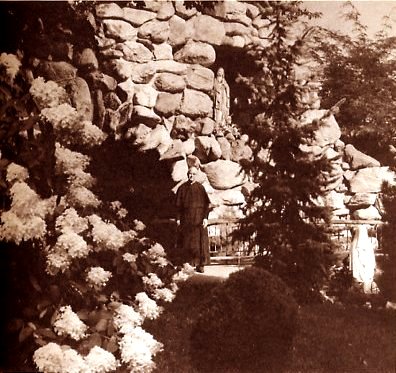
All the thinking
Dreaming, working,
Will chase those blues
From where they’re lurking.
For half the reward
For patiently waiting,
Is in the vision
You’re anticipating.
In life
There is nothing more sweet
Then when a dream and you meet,
Then all of life
Becomes a delicious treat.
The beauty
Of nature’s sights and sounds,
Will on this spacious earth abound,
When in this world
You’ve finally found
A dream to build your life around.
D.Verne
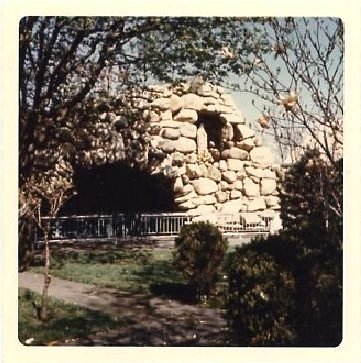 Some friendships come into being because of special circumstances and so it was that Father Jan and I became Providential friends. For me the enlarging experience of our interlude of friendship has ended, but will never be forgotten. He has taken its heavenly riches with him while fond earthly remembrances remain to warm my heart.
Some friendships come into being because of special circumstances and so it was that Father Jan and I became Providential friends. For me the enlarging experience of our interlude of friendship has ended, but will never be forgotten. He has taken its heavenly riches with him while fond earthly remembrances remain to warm my heart.The Father Jan I knew was a kind, gentle, tender-hearted human being. Loving and generous in his nature, while single-minded in his search for beauty and truth. We will all miss him and all he stood for. In the end, he won the victory over his own too human nature setting an inspiring and uplifting example of patience, compliance, and abandonment to Divine Providence.
By accident of birth I am not Catholic, but having known Father Jan, in so many ways, I have become catholic in my heart in the truest sense of the word -- in sympathy with all -- and so I know a fragrance of his loving veneration will always linger at the St. Stan’s Grotto – his humble gift to Our Lady – and to the parishioners he lived his life for.
Father Jan would have been so pleased that he departed from this life on, October 7, 1975, the Feast Day of Our Lady of the Rosary, to whom he had dedicated his life. A beautiful sunshiny autumn day I will always associate with fond memories.